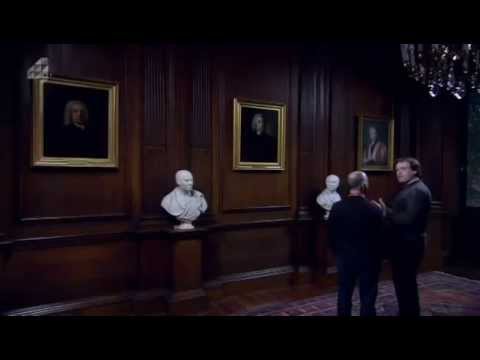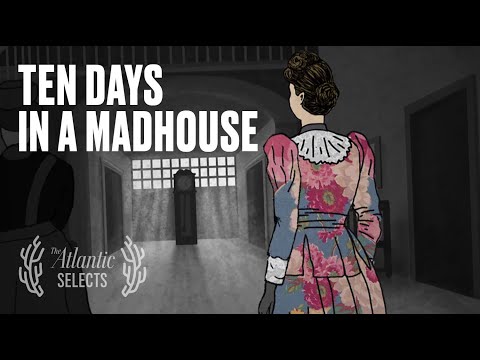Most of the hundreds of thousands of patients in the dark days of the “madhouses” were unknown paupers and not remembered. Occasionally though, throughout history, certain patients have been rather more well-known. Here are ten examples of the somewhat famous, very famous, and downright infamous locked away in an asylum.
10 King George III
England’s King George III reigned from 1760 until his death in 1820 and suffered severe mental health problems at times. Although causing occasional mockery, the idea that even a king could suffer from madness also generated increased sympathy toward other sufferers. He became prone to ranting, convulsions, erratic behavior, and depression and was taken to the private Greatford House Asylum in Lincolnshire. His treatment there would have been typical of its time—painful and completely ineffectual—including bleeding, induced vomiting, and blistering of the skin with hot glass vials. While historians often suggest his condition may have been a genetic blood disorder called porphyria rather than madness, recent studies by London’s St. George’s University suggest it was most likely a mental health problem, possibly bipolar disorder, which afflicted the king.[1]
9 Ronnie Kray
Ronald “Ronnie” Kray was one-half of the notorious “Kray Twins,” born in East London in 1933. With his brother Reginald “Reggie” Kray, the identical twins ruled London’s gangland during the 1950s and 60s, glamorizing it with their penchant for stylish suits, celebrity parties, and brutal violence. Imprisoned in 1956 and separated from his beloved brother, Ronnie’s already ailing mental health deteriorated further. In 1957, he was committed to one of the secure wards at Long Grove Asylum in Surrey, where he was so unwell he formed a relationship with a radiator and believed another patient to be a dog. An audacious plan was hatched to break him out—Reggie and his entourage visited, with Reggie dressing as similarly as possible to Ronnie. Meeting in the bathroom, Ronnie handed his distinctive black-rimmed glasses to Reggie before the two returned. Ronnie walked out with the others as Reggie remained, staff, assuming Reggie was Ronnie while his brother made good his escape. Shortly, Reggie took off his brother’s glasses and signed out, leaving unchallenged to join the others back in London. Both received life sentences for murder in 1969, with Ronnie being transferred to Broadmoor Asylum in 1979, where he would remain until his death in 1995.[2]
8 Louis Wain
Born in 1860, Louis Wain drew for newspapers and magazines in the 1880s to support his mother and five sisters after his father’s death. His greatest success came when he began drawing stylized cartoons of cats engaged in human-like activities, bringing him modest fame and fortune. When his wife and love Emily died of cancer three years into marriage, his mental state deteriorated, while his cats began to take increasingly bizarre form. He also made a series of incredible futurist pottery figures during this time. Increasingly ill, his trusting nature saw him swindled out of most of his money and eventually admitted to Springfield Asylum in London as a pauper in 1924. Discovered there a year later, a fundraising campaign (endorsed by the likes of War of the Worlds author H.G. Wells) was organized. Wain was moved to the more comfortable Bethlem Royal in Kent and then Napsbury Asylum, where he continued to paint stunning, psychedelic images of cats until he died in 1939.[3]
7 Vincent Van Gogh
Van Gogh admitted himself to the asylum of St. Paul de Mausole in Saint Remy, France, in 1889. He had two rooms there—one to sleep in and another to use as his studio. Although the regime was not deliberately harsh, he received only meager food and water, his “treatment” consisting only of bathing. Eventually, he was allowed to wander the picturesque gardens, then finally, the fields beyond. He would paint many images of the asylum and its surroundings while there. Watch this video on YouTube His shift to darker colors during his time at the asylum led to Starry Night, one of his most famous and evocative works created there.[4]
6 Margaret Nicholson
Margaret Nicholson lost several prestigious housekeeping jobs due to scandalous affairs with other employees, eventually struggling to eke out a living as a seamstress. She developed a fixation on the royal family, believing she should be queen. In 1776, she was injudiciously allowed to approach King George III when she whipped out a knife and lunged at him. The king was unharmed—she made her assassination attempt wielding only a blunt cake knife. Nicholson then suffered the indignity of being strip-searched to confirm she was not, in fact, a man. After stating, “England would be drowned in blood for a thousand generations” if she wasn’t queen, she was declared mad, escaping almost certain execution and being sent to Bedlam asylum instead. King George wrote to say she should be given sympathetic treatment while there. Nicholson received many well-to-do guests who brought her gifts and were keen to meet the “celebrity madwoman.” She remained in Bedlam until her death at age 83.[5]
5 John Clare
Born in 1793, Clare lived in the small village of Helpston, UK, working as a “potboy” at The Blue Bell Inn. He sold poetry to stave off his parents’ eviction, meeting with quick success and early recognition. When his last collection, The Rural Muse (1835), gained praise but poor sales, his existing mental problems and alcoholism intensified. After attacking an actor on stage, he was advised to attend High Beach Asylum in Essex and said to have believed he was Lord Byron and had two wives, one of whom was his first love Mary who died three years earlier. Missing his family, he left and walked the 80-mile (130-kilometer) journey back home alone. In 1841, he was admitted to St. Andrew’s Asylum in Northampton as a pauper, where he was encouraged to continue writing and produced his most famous work, “I Am.” He would remain in the asylum until his death in 1864. In obscurity by that time, his work was reappraised over the following century, and he is now among Britain’s most highly-regarded poets.[6]
4 Richard Dadd
Richard Dadd was a talented young painter recruited to accompany a grand tour of Europe and Asia, providing sketches and paintings of the trip as was fashionable among the wealthy of the time. In Egypt, he suffered intense headaches and sunstroke, believing he could hear the voice of the sun god Osiris. When the expedition reached Paris in 1843, his behavior had become so odd he was dismissed. At London’s St. Luke’s Asylum, he was diagnosed insane, but his father was reluctant to commit him and took him home instead. Osiris urged him to battle the devil, and Dadd began to see Satan in everyone around him. He withdrew to his rooms, living only on ale and hard-boiled eggs. Dadd’s father asked him to “unburden his mind,” taking him for a meal and walk on a local heath, where Richard stabbed his father to death. Tragically, he planned the attack believing his father was the devil in disguise. His rooms were searched, with police discovering drawings of friends and relatives with their throats cut. Dadd fled to Calais intent on killing the Emperor of Austria, but after attempting to kill a fellow passenger, he was arrested and committed to Clermont Asylum at Fontainebleau. Confessing to murder, he was then extradited to England. Dadd was committed to Bedlam and then moved to Broadmoor Asylum, where he produced many of his most celebrated works, including The Fairy-Feller’s Masterstroke (1864). He would eventually die in 1886. His works, now worth millions, can be seen at The National Gallery and the Tate Gallery, among others.[7]
3 James Tilley Matthews
Matthews was, by day, a mild-mannered London tea seller but had a remarkable alter-ego. In Revolutionary France, he worked brokering peace between England and the new Republican leadership. When those he supported failed to gain power, he was arrested, accused of being a spy, and imprisoned. Eventually liberated, he claimed the English government had abandoned him to the French and that the Home Secretary was at the heart of a series of conspiracies. His wild and often very public talk about having been a Scarlet Pimpernel-esque double-agent saw him committed to Bedlam asylum in 1798. Two doctors certified Matthews sane, but Lord Liverpool stated he was “a dangerous lunatic who should be confined in perpetuity,” backed by Bedlam’s apothecary, John Haslam, who studied Matthews for his book Illustrations of Madness (1810). Many consider this to be the first case study of paranoid schizophrenia. Matthews believed a criminal gang constantly interfered with his mind through “pneumatic chemistry,” using magnetic waves from their “air loom” device. This would inflict on him such pains as “lobster-cracking,” which made his circulation stop, and “apoplexy-working with the nutmeg-grater,” which tracked his thoughts and movements. Haslam’s book is still used to show the terrifying thoughts and conspiracies which can be typical of schizophrenia. Subsequent research suggests Matthews had indeed been in France unofficially backed by the British government, keen to see the “correct” people end up in power. These “invisible forces” then denied all knowledge of Matthews upon capture and maintained a wall of silence upon his return, suggesting his illness may not have been the only factor ensuring he remained conveniently locked away in an asylum for good.[8]
2 Nellie Bly
Elizabeth Seaman (1864-1922) was a journalist born in Pennsylvania, better known by her pen name Nellie Bly. She is most famous for two particular journalistic endeavors, the second of which was traveling around the world in just seventy-two days (a world record at that time) in emulation of the famous book by Jules Verne. She first made waves in 1887 with an undercover exposé of life in a lunatic asylum. Taking up residence in a women’s boarding house, she tried to act as strangely as she could but found such behavior was so common there as to be barely noticed. Eventually escalating until she began to scare the other residents and the police were called, she was finally committed to New York’s Blackwell’s Island Asylum for women. Once inside, her task was to appear as “normal” as she possibly could, to see how she would be treated knowing she was sane and exhibiting no unusual behavior. Her subsequent exposé, “Ten Days in a Madhouse,” hinged on how difficult she would then find it to be taken seriously or affect her release despite her obvious sanity and the appalling conditions experienced by the other women incarcerated there. She was unable to convince anyone, and the newspaper she worked for eventually had to contact the asylum to arrange for her release.[9]
1 Jack the Ripper
While the true identity of the world’s first celebrity serial killer has never been proven, several suspects ended up in asylums. One Aaron Kosminski was even named as a prime suspect by two of the case’s key investigating police officers. Some believe Kosminski may have been mixed up with another patient named Nathan Kaminsky, who had been arrested in Whitechapel in December 1888, at which time the murders abruptly stopped. This would explain why Kosminski did not at all fit the description of a killer when he was visited by the investigating officers and essentially suggests that the asylum brought them the wrong suspect to see. On the other hand, Kaminsky was apprehended in a state of severe aggression less than a month after the final killing, after which he attacked anyone he could at the asylum and had to be kept in restraints. While it will likely remain only a theory, it is a fascinating potential explanation of the demise of the world’s most notorious serial killer—the killings stopped because he was locked up in London’s Colney Hatch Asylum.[10]
























